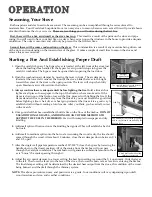
OPERATION
Seasoning Your Stove
Both soapstone and steel need to be seasoned. The seasoning can be accomplished through a series of small to
moderate fires. Your Woodstock Soapstone Stove is an easy stove to season, because even a small fire will provide hours
of radiant heat once the stove is warm.
There are two things you will notice during the first fire
:
First, there will be a hot, acrid smell as the stove heats up
. This smell is a result of the paint on the stove and pipe
curing. You will want to have your first fire on a day when you can open the windows in the house to provide adequate
ventilation. The odor is non-toxic and will only be present for the first few fires.
Second, there will be some condensation on the glass.
This condensation is a result of any moisture being driven out
of the stove and condensing on the inner surface of the glass. It takes a couple of small fires to season the stove and
remove this excess moisture.
Starting a Fire And Establishing Proper Draft
1. Open the catalytic bypass. The bypass lever is located at the left front of the stove just
above the loading door handle.Lift the bypass lever up until it stops to bypass the
catalytic combustor. The bypass must be opened before opening the load door.
2.
Open the combustion air damper by moving the lever in front . The air damper is
located at the lower left corner at the front of the stove. Slide the lever to the right
toward the center of the stove to the open position. The lever will stop when fully
open. Maximum air is allowed into the firebox.
3. Always confirm there is adequate draft before lighting the fire.
Hold a lit match or
light a small piece of newspaper in the top of the firebox, where smoke exits. If the
flame is drawn out of the firebox, toward the flue, proceed with lighting the fire. If the
flame stands still or is pushed away from the flue exit, you must establish a good draft
before lighting a fire. A hair dryer or heat gun pointed at the flue exit is a good way to
establish draft without creating a lot of smoke. After you think you have draft, re-test
with a match.
4.
Once good draft has been established, build a fire on the floor of the firebox.
DO NOT
USE ADDITIONAL GRATES, ANDIRONS OR ANY OTHER METHODS TO
SUPPORT THE FUEL IN THE FIREBOX
. Start with crumpled newspaper and dry
kindling.
5.
Add small splits of firewood once the kindling has ignited. This will establish a bed of
hot coals.
6.
Add small to medium splits onto the hot coals. Assuming the wood is dry, the fire should
spread through the wood. After about 10 minutes, close the air damper down between 3/4
and 1/2 open.
7.
After the single wall pipe temperature reaches 250°-300°F, close the bypass by lowering the
handle down to the closed position. All of the smoke from the firebox will now pass
through the catalytic combustor. The combustor will generate a substantial amount of heat
as it “burns” the smoke passing through it.
8.
Adjust the air control damper to a lower setting, the best burn setting is around the 1/4 open mark. Slide the lever
to the left. The closer the lever is to the face of the stove, the lower the burn rate, as less air is entering the firebox.
The final damper setting will be determined by the desired heat output from the stove, the condition of the wood
being burned, and the draft through the chimney system.
NOTE:
The above procedures, times, and positions are a guide. Your conditions will vary depending upon draft,
wood moisture and size, and weather conditions.
The amount of combustion air avail-
able in the firebox is controlled by the
damper lever.
14
Ash Lip
Check draft and preheat the
chimney if necessary
The catalyst bypass lever interlocks
with the front load door
Catalyst
Bypass Lever
Air Control























